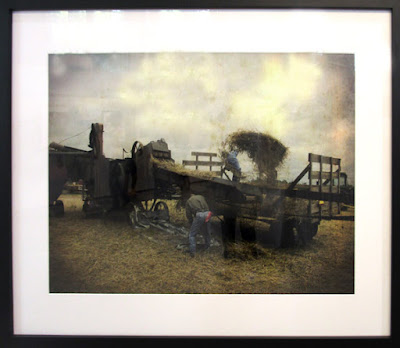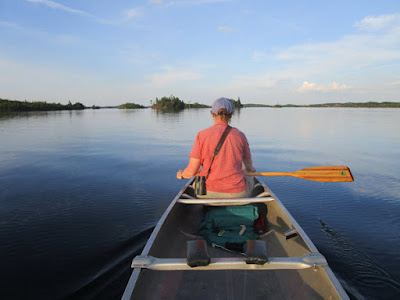Our first two attempts to visit the state fair were aborted
this year. On Sunday morning the line into the Larpenteur parking lot extended
west beyond the University golf course. It was simply too long. On Monday
morning we got a late start due to a dentist appointment; the line seemed
manageable, but just as it we got to the parking lot entrance someone brought
out the LOT FULL sign.
(There are other places to park, I know, but the "bloom"
would be off the morning by the time we got inside.)
Wednesday morning we
left the house at 7:30, waited patiently in the long line stretching west down
Larpentuer Avenue, and finally bought our tickets and entered the fairgrounds
at 8:40. We had no trouble finding something to do for the 20 minutes before
the Eco-Building opened, because we almost immediately ran into an old friend
of mine, Jim Hoey, and his wife, Ann. Jim and I have done four books together,
and I think he's cooking up a fifth. "But I can't write in the
summer," he said. "I take care of seven properties for a realtor
friend of mine and I have too much grass to mow."
I don't have that problem. I hired a lawn firm to kill the
creeping Charlie in our yard, and when they were done eradicating it, it turned
out I didn't have any grass.
The displays in the
Eco-Building get better every year. Solar Power, wind power, clean water,
recycling, agricultural runoff, bicycle transport, peace coffee, kobucha, composting, kayaking on the Mississippi, all
presented in a cheery easy-to-read displays, interactive kiosks, and clever
do-it-yourself demonstrations.
I talked at length to the woman at the Gitchi
Gummi booth about Duluth, and she gave Hilary a rub-on tattoo of Lake Superior.
The woman at the PCA booth told us a little about the challenges of dealing
with the Trump administration.
At the "water bar" we sampled tap
water from St. Paul (which gets its water from the Mississippi), Duluth (which
gets it from Lake Superior), and tiny Buhl (which gets its famous water from a
deep aquifer). The differences were subtle—almost undetectable. I suggested to
the young man pouring the samples that they serve crackers.
As we wandered the hall I ran into another old
author-friend, Stew Thornley, with whom I've worked on several books. Though
he's an official scorer for the Minnesota Twins, his day job is with the
Department of Health, and he was scheduled
to give a demonstration about water quality that morning.
At one modest booth we spoke with the same tree
"expert" who advised us last
year to cut down a big maple in our front yard because it had a few dead
branches. "You never know," she said. "One might fall on you."
This year, I asked her what might be a good thing to plant
under some malingering blue spruce in the back yard. "Nothing," she
said. "Anyway, blue spruce don't live much more than 30 years in
Minnesota." I happen to know that the trees in our yard are now 70 years
old at least, because my neighbor planted them in 1948.
I told her we had some volunteer ash coming up in the
understory. "Ash are not good; they'll get green ash borer."
The woman was pleasant to talk to, and it occurred to me
only in retrospect that she had a rather negative view of plant life, generally
speaking.
Out in front of the building we did a lot better, chatting
with a garden expert who confirmed most of my ideas about our ailing yard. "Moss? Lucky you! Why not add some
clover?" But that's a story for another time.
The art building is
always a highlight, for both the diversity of mediums and the wide range of styles
on display, which you'll find at no other art exhibit that I know of. The sheer volume of pieces eventually tends to
numb the brain, yet it's a healthy challenge to see if you can plot a route
through the many side halls that will allow you to see them all.
This year, as usual, there were many beautiful but generic
travel photos, angst-ridden but mediocre self-portraits, and clever
non-representational "concept" piece that relied on their titles to
get the point across. As I shuffled from image to image along with all the other
gawkers, I was immediately thrilled by the bright colors and the impressive
frames and mounting techniques of the pieces. Presentation isn't everything,
but it counts for a lot. In fact, the very first piece in the line-up, a bright
yet rich and dense photo of a poor Cuban family sitting on a couch together, a
few of them wearing boxing gloves, packed a punch. At the next turn I saw a piece
that impressed because of the medium being used. "Wow! How did he do that
with colored pencils?"
There are always a few watercolors with an Asian
inflection—a few stylized branches, two cranes in the distance. There are
plenty of North Woods scenes. And no exhibit would be complete without five or
six paintings of cows—a subject which, like old boots, is hard to botch
completely, but also hard to imbue with any kind of depth.
This year there were a surprising number of photos of
horses, in Wales or Iceland or wherever, and holy men from India or Thailand seemed
to pop up at every turn of the labyrinth.
My favorite piece was a photograph of men harvesting hay.
It's a dark image, but it has the fury of desperation in it, as well as several
marks of subtle artistry—the red hanky in one of the farmhand's back pocket,
for example. The photo has a satisfying gravitas;
It reminded me of the nineteenth-century French painter Géricault.
Another fine piece, a few walls down the way, was an oil
painting of a vase of peonies. The subject is conventional, of course, but in the folds of the petals and the shadows
beyond the stems the artist takes us beyond appearances into melancholy depths
that had me returning to it several times. Like Fantin-Latour, only better.
As we moved through the exhibition, I noticed at a certain
point that the images I was drawn to most often presented patterns—usually
organic—rather than representations. I
was mesmerized by drops of water on a dead leaf ...
and enthralled bye a Zen-like
script that was actually a photo of bent reeds on a still pond.
One image offered a colorful vision of my favorite state in
the manner of Giuseppe Arcimboldo, the
sixteen-century master of vegetable art.
I seemed to be taking a special interest in leaves, but this little piece had a subtle modulation between the various greens and a relaxed ambiance.
Alongside the zany, we also need to make room for the
whimsical.
I happened upon my favorite political statement amid the cookies in the
handicraft building.
Yet the works that I liked best often had a modern slant.
Back on the street, we stood in line for 12 minutes to get our hands on one
of the Star-Tribune's highly-rated new foods, the Heirloom Tomato and Sweet
Corn BLT. Food critic Rick Nelson writes:
"The BLT is God’s gift to sandwiches. In the hands of Birchwood Cafe chef Marshall Paulsen — and his vast network of Minnesota organic farmers — it’s elevated into a heaven-sent fair experience. No detail is left to chance in this ingenious and obviously labor-intensive effort, from the swipes of basil-kale-sunflower seed pesto and chipotle-fueled sweet corn purée, right down to the sturdy focaccia, baked by Baker’s Field Flour & Bread in Minneapolis. Truly spectacular. $12."
Indeed, it was good.
We climbed the fire tower but skipped the all-you-can-drink
milk stand, and later we ran into our friend Cindy Purser in front of the
grandstand, where she was tending a booth for the public library association.
The day was cool and clear, and the scene was colorful and
not too crowded. A perfect day. A heavenly day. We even bought some Norwegian
cardamom cookies from a woman in the Osakis Bakery booth that we'd met this summer out in Osakis. (I can see this becoming a yearly tradition.)
We listened in passing to a hoe down violin-cello duet in front of the MPR building, and also endured some excruciating karaoke in a beer garden in the food building while we ate some delicious wood-grilled elote topped with jalapeno powder.
We listened in passing to a hoe down violin-cello duet in front of the MPR building, and also endured some excruciating karaoke in a beer garden in the food building while we ate some delicious wood-grilled elote topped with jalapeno powder.
But we never made it to the animal barns and didn't see a single chicken or goat!










































